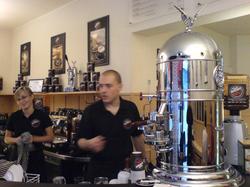 Let me tell you where to currently get the best espresso coffee in London: at the small Caffé Vergnano 1882 on 62 Charing Cross Road, London.
Let me tell you where to currently get the best espresso coffee in London: at the small Caffé Vergnano 1882 on 62 Charing Cross Road, London.
I was lured in by a sign saying “voted best coffee shop in London 2005” but did not have any expectations. Yet another publicist trick I thought.
The caffé is fairly small. Just a few tables and two bars along the window and the wall. When I visited there were three staff working and they were skilled and very efficient.
First thing you notice when you enter the shop however is the massive Elektra Bell Epoque Q1-C espresso machine.
On a note on the wall you find out that these machines are hand made and only a few (10?) are made each year. The Vergnano coffee company elects each year a European Vergnano coffee shop and lend them one of these “Rolls-Royces” of espresso machines. This is the first time ever a London shop has had the honour.
I ordered a double macchiato which was brewed very well. Good temperature, excellent taste and no bitterness nor sourness. The barista even made a perfect rosetta on top of the coffee, effortlessly.
Each coffee is served on a tray with accompanying glass of water. Do it right and have the water before the coffee to clean your palate.
All the coffee machines, grinders, tables (and staff) are so clean and sparkling that you could almost make the mistake and think that the shop is closing or closed. This is however another sign of perfection and that coffee making is taken very seriously in here.
The coffee experience was so good and such a surprise that I had to have a second double macchiato just to assure my self that it had been for real.
Getting there: get off at Leicester Square tube station. Walk North along Charing cross road. The café is on the left side, just a few blocks up.
Tag: coffee
Perfect espresso shots with Rancilio Silvia
 I am bit ashamed to admit that only after 12 months of owning the heavy duty espresso machine Silvia am I starting to get decent coffee results. If you are struggling with your Silvia do read on and your espressos and cappuccinos will improve.
I am bit ashamed to admit that only after 12 months of owning the heavy duty espresso machine Silvia am I starting to get decent coffee results. If you are struggling with your Silvia do read on and your espressos and cappuccinos will improve.
The perfect espresso is a combination of: beans, grind, tamping, temperature and pressure.
For the perfect espresso you need fresh coffee. Coffee beans preserve the aroma much better than ground coffee and you should always start preparing your shot by grinding your own beans. Keep in mind that not even beans stay fresh any longer than 2 weeks.
There are mainly two types of grinders: blade and burr grinders. A blade grinder will produce inconsistent size grind and will generate more heat during the grinding process. Simply put, stay away from blade grinders.
The act of packing the coffee into the porta-filter is called tamping. The aim is to create an evenly compressed puck of coffee that sticks well to the sides of the porta-filter. Only then can hot water run evenly through the coffee and produce top beverage.
Start by pouring coffee loosely into the porta-filter and level it out with a finger. Apply a first tamp to press the coffee down. Some of the coffee is now probably sticking to the sides of the porta-filter so tap the porta-filter gently against something to knock the grounds back on top of the coffee puck.
I prefer to do the final tamping in a 5-step process. North, South, West, East and a final tamp in the middle, as hard as I can. You should now have a porta-filter filled with a flat and evenly distributed pellet of coffee.
If you run water that is not hot enough through your coffee, you will end up with a sour espresso. There is a trick to make Silvia to produce water of a consistent temperature.
Turn on the hot water button and keep emptying water into a jug until the boiler light turns on again. This means that the boiler has started to heat up water again. Wait for the light to turn off before hitting the espresso button.
This procedure should result in always the same and optimal water temperature. Instead of emptying the water into a jug, you can preheat one or two espresso cups that you will be using.
If you are going to make cappuccinos, you can save some pressure building-up time by turning on the pressure button at the same time as the espresso button. This will trigger Silvia to start creating steam pressure while your espresso is running through. I have noticed that by turning on the steam button 10-30 seconds before starting an espresso run, extra pressure will be built up and the water will penetrate the coffee puck better.
The ideal time for an espresso is often quoted as 25-30s from the moment you switch the espresso button. If your espressos are quicker than this they will be bland, see below for possible problems. Too long and your espresso shots will taste burned or over extracted.
A common problem is water channeling. This occurs when the coffee pellet is uneven and water finds channels through which to pass quicker. If your coffee pellet isn’t sticking to the sides of the porta-filter, similar problem occurs.
If your grinds are too course water will run through too quickly resulting in a bland espresso.
In case of course grinds, try over packing the porta-filter:
After you have packed the coffee as described above, add some additional coffee on top and pack again. This will result in a larger amount of coffee, higher pressure and hopefully a better espresso.
Never should you steam milk before making an espresso. The Silvia has only one channel and the pressure that is built up during the steaming of the milk needs to be vented before making an espresso.
Otherwise you will end up with a mess when the high pressure steam pushes through the porta-filter. Trust me, been there done that.
Brew on!
See the Rancilio Silvia espresso machine forum for any questions or our tips.
